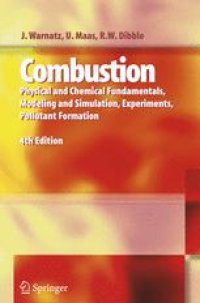
Ebook: Combustion: Physical and Chemical Fundamentals, Modeling and Simulation, Experiments, Pollutant Formation
- Tags: Engineering Thermodynamics Transport Phenomena, Physical Chemistry, Atmospheric Protection/Air Quality Control/Air Pollution, Industrial Chemistry/Chemical Engineering, Mechanics Fluids Thermodynamics, Engineering Fluid Dynamics
- Year: 2006
- Publisher: Springer-Verlag Berlin Heidelberg
- Edition: 4
- Language: English
- pdf
Combustion is an old technology, which at present provides about 90% of our worldwide energy support. Combustion research in the past used fluid mechanics with global heat release by chemical reactions described with thermodynamics, assuming infinitely fast reactions. This approach was useful for stationary combustion processes, but it is not sufficient for transient processes like ignition and quenching or for pollutant formation. Yet pollutant formation during combustion of fossil fuels is a central topic and will continue to be so in the future. This book provides a detailed and rigorous treatment of the coupling of chemical reactions and fluid flow. Also, combustion-specific topics of chemistry and fluid mechanics are considered and tools described for the simulation of combustion processes.
The actual fourth edition presents a completely restructured book: Mathematical Formulae and derivations as well as the space-consuming reaction mechanisms have been replaced from the text to appendix. A new chapter discusses the impact of combustion processes on the earth’s atmosphere, the chapter on auto-ignition is extended to combustion in Otto- and Diesel-engines, and the chapters on heterogeneous combustion and on soot formation appear heavily revised.
Combustion is an old technology, which at present provides about 90% of our worldwide energy support. Combustion research in the past used fluid mechanics with global heat release by chemical reactions described with thermodynamics, assuming infinitely fast reactions. This approach was useful for stationary combustion processes, but it is not sufficient for transient processes like ignition and quenching or for pollutant formation. Yet pollutant formation during combustion of fossil fuels is a central topic and will continue to be so in the future.
This book provides a detailed and rigorous treatment of the coupling of chemical reactions and fluid flow. Also, combustion-specific topics of chemistry and fluid mechanics are considered and tools described for the simulation of combustion processes.
The fourth edition has been restructured: Mathematical Formulae and derivations as well as the space-consuming reaction mechanisms have been replaced from the text to appendix. A new chapter discusses the impact of combustion processes on the earth’s atmosphere, the chapter on auto-ignition is extended to combustion in Otto- and Diesel-engines, and the chapters o
Combustion is an old technology, which at present provides about 90% of our worldwide energy support. Combustion research in the past used fluid mechanics with global heat release by chemical reactions described with thermodynamics, assuming infinitely fast reactions. This approach was useful for stationary combustion processes, but it is not sufficient for transient processes like ignition and quenching or for pollutant formation. Yet pollutant formation during combustion of fossil fuels is a central topic and will continue to be so in the future.
This book provides a detailed and rigorous treatment of the coupling of chemical reactions and fluid flow. Also, combustion-specific topics of chemistry and fluid mechanics are considered and tools described for the simulation of combustion processes.
The fourth edition has been restructured: Mathematical Formulae and derivations as well as the space-consuming reaction mechanisms have been replaced from the text to appendix. A new chapter discusses the impact of combustion processes on the earth’s atmosphere, the chapter on auto-ignition is extended to combustion in Otto- and Diesel-engines, and the chapters o
Content:
Front Matter....Pages I-XII
Introduction, Fundamental Definitions and Phenomena....Pages 1-8
Experimental Investigation of Flames....Pages 9-28
Mathematical Description of Premixed Laminar Flat Flames....Pages 29-38
Thermodynamics of Combustion Processes....Pages 39-56
Transport Phenomena....Pages 57-72
Chemical Kinetics....Pages 73-90
Reaction Mechanisms....Pages 91-118
Laminar Premixed Flames....Pages 119-128
Laminar Nonpremixed Flames....Pages 129-140
Ignition Processes....Pages 141-164
Low Temperature Oxidation, Engine Knock....Pages 165-178
The Navier-Stokes Equations for Three-Dimensional Reacting Flows....Pages 179-186
Turbulent Reacting Flows....Pages 187-212
Turbulent Nonpremixed Flames....Pages 213-226
Turbulent Premixed Flames....Pages 227-238
Combustion of Liquid and Solid Fuels....Pages 239-258
Formation of Nitric Oxides....Pages 259-276
Formation of Hydrocarbons and Soot....Pages 277-296
Effects of Combustion Processes on the Atmosphere....Pages 297-318
Appendix 1: Mathematics....Pages 319-332
Back Matter....Pages 345-378
Appendix 2: Reaction Mechanisms....Pages 333-344
Combustion is an old technology, which at present provides about 90% of our worldwide energy support. Combustion research in the past used fluid mechanics with global heat release by chemical reactions described with thermodynamics, assuming infinitely fast reactions. This approach was useful for stationary combustion processes, but it is not sufficient for transient processes like ignition and quenching or for pollutant formation. Yet pollutant formation during combustion of fossil fuels is a central topic and will continue to be so in the future.
This book provides a detailed and rigorous treatment of the coupling of chemical reactions and fluid flow. Also, combustion-specific topics of chemistry and fluid mechanics are considered and tools described for the simulation of combustion processes.
The fourth edition has been restructured: Mathematical Formulae and derivations as well as the space-consuming reaction mechanisms have been replaced from the text to appendix. A new chapter discusses the impact of combustion processes on the earth’s atmosphere, the chapter on auto-ignition is extended to combustion in Otto- and Diesel-engines, and the chapters o
Content:
Front Matter....Pages I-XII
Introduction, Fundamental Definitions and Phenomena....Pages 1-8
Experimental Investigation of Flames....Pages 9-28
Mathematical Description of Premixed Laminar Flat Flames....Pages 29-38
Thermodynamics of Combustion Processes....Pages 39-56
Transport Phenomena....Pages 57-72
Chemical Kinetics....Pages 73-90
Reaction Mechanisms....Pages 91-118
Laminar Premixed Flames....Pages 119-128
Laminar Nonpremixed Flames....Pages 129-140
Ignition Processes....Pages 141-164
Low Temperature Oxidation, Engine Knock....Pages 165-178
The Navier-Stokes Equations for Three-Dimensional Reacting Flows....Pages 179-186
Turbulent Reacting Flows....Pages 187-212
Turbulent Nonpremixed Flames....Pages 213-226
Turbulent Premixed Flames....Pages 227-238
Combustion of Liquid and Solid Fuels....Pages 239-258
Formation of Nitric Oxides....Pages 259-276
Formation of Hydrocarbons and Soot....Pages 277-296
Effects of Combustion Processes on the Atmosphere....Pages 297-318
Appendix 1: Mathematics....Pages 319-332
Back Matter....Pages 345-378
Appendix 2: Reaction Mechanisms....Pages 333-344
....